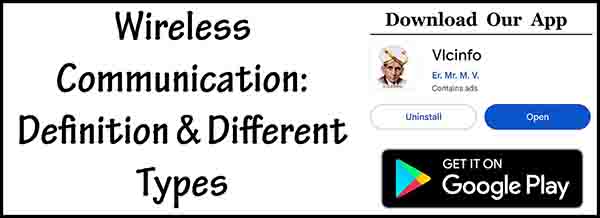Here you will get knowledge about “Wireless Communication, its Definition & Different Types”. We have described all types of Wireless Communication in detail here. You will get complete knowledge about Wireless Communication here. Keep Visiting – Vlcinfo.
Definition of Wireless Communication
- It is a transfer of data without using physical connections (wires or cables).
- It uses radio frequency waves for transmission of data.
- Examples:
- Phones
- Tablets
- Laptops
- Routers
- IoT devices
- These devices use wireless technology for each other communication.
Different Types of Wireless Communication
Here we have listed different types of wireless communication below,
1. Wi-Fi
- Full Form: Wireless Fidelity
- It uses IEEE 802.11 standards.
- It is used in limited area (home, office, campus or public hotspot).
- Works in 2.4 GHz to 5 GHz frequency bands.
2. Bluetooth
- Used for short-range communication
- Used within range of 10 meters.
- Works in 2.4 GHz frequency band.
3. Satellite Communication
- It uses satellites to provide signals over long distances.
- It provides transfer of voice, data and multimedia services globlly.
- It is used in satellite phones, satellite television, GPS and remote sensing.
- It is used for marine and aviation communication, disaster response and military communication.
4. Infrared Communication
- It uses infrared light waves to transfer data.
- It is used over short distances.
- It needs direct line of sight between the transmitter and a receiver
5. Cellular Communication
- It uses cell tower network to transfer data.
- It is used over large geographic areas.
- Uses :
- To make voice calls
- Send text messages and
- Access the internet on mobile devices.
6. NFC (Near Field Communication)
- It is used for very close-range communication
- Used within a few centimeters.
- Works in 13.56 MHz frequency band.
- Uses :
- Contactless payments
- Ticketing
- Access control
- Data exchange
- Smart cards
- NFC tags and
- NFC-enabled devices.
7. RFID (Radio Frequency Identification)
- It uses radio waves. For identification and tracking of objects.
- It consists :
- (1) RFID tags (transponders) attached to objects
- (2) RFID readers (interrogators).
- Uses :
- Inventory management
- Ticketing
- Access control
- Contactless payment
- Supply chain management

